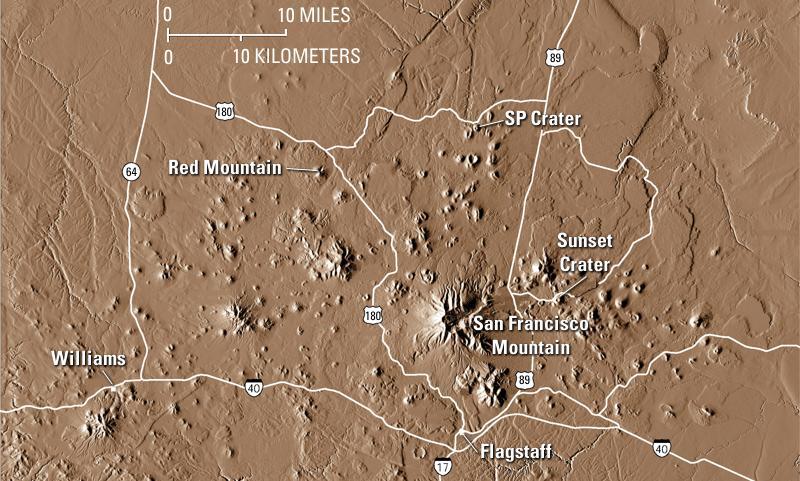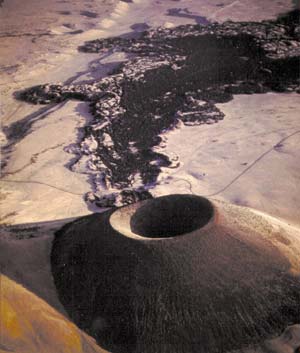San Francisco volcanic field on:
[Wikipedia]
[Google]
[Amazon]

 The San Francisco volcanic field is an area of
The San Francisco volcanic field is an area of
 Popular tourist and hiking destinations in the volcanic field include the
Popular tourist and hiking destinations in the volcanic field include the

Satellite view of San Francisco Volcanic Field
{{Authority control Colorado Plateau Landforms of Coconino County, Arizona Polygenetic volcanic fields Regions of Arizona Volcanic fields of Arizona Miocene volcanism Pliocene volcanism Pleistocene volcanism Holocene volcanism de:San Francisco Peaks

 The San Francisco volcanic field is an area of
The San Francisco volcanic field is an area of volcano
A volcano is a rupture in the crust of a planetary-mass object, such as Earth, that allows hot lava, volcanic ash, and gases to escape from a magma chamber below the surface.
On Earth, volcanoes are most often found where tectonic plates ...
es in northern Arizona
Arizona ( ; nv, Hoozdo Hahoodzo ; ood, Alĭ ṣonak ) is a state in the Southwestern United States. It is the 6th largest and the 14th most populous of the 50 states. Its capital and largest city is Phoenix. Arizona is part of the Fou ...
, north of Flagstaff, US. The field covers 1,800 square miles (4,700 km²) of the southern boundary of the Colorado Plateau
The Colorado Plateau, also known as the Colorado Plateau Province, is a physiographic and desert region of the Intermontane Plateaus, roughly centered on the Four Corners region of the southwestern United States. This province covers an area o ...
. The field contains 600 volcanoes ranging in age from nearly 6 million years old to less than 1,000 years (Miocene
The Miocene ( ) is the first geological epoch of the Neogene Period and extends from about (Ma). The Miocene was named by Scottish geologist Charles Lyell; the name comes from the Greek words (', "less") and (', "new") and means "less recen ...
to Holocene
The Holocene ( ) is the current geological epoch. It began approximately 11,650 cal years Before Present (), after the Last Glacial Period, which concluded with the Holocene glacial retreat. The Holocene and the preceding Pleistocene togeth ...
), of which Sunset Crater is the youngest. The highest peak in the field is Humphreys Peak
Humphreys Peak ( hop, Aaloosaktukwi, nv, Dookʼoʼoosłííd) is the highest natural point and the second most prominent peak after Mount Graham in the U.S. state of Arizona, with an elevation of and is located within the Kachina Peaks Wildern ...
, at Flagstaff's northern perimeter: the peak is Arizona's highest at 12,633 feet (3,851 m) and is a part of the San Francisco Peaks
The San Francisco Peaks (Navajo: , es, Sierra de San Francisco, Hopi: ''Nuva'tukya'ovi'', Western Apache: ''Dził Tso'', Keres: ''Tsii Bina'', Southern Paiute: ''Nuvaxatuh'', Havasupai-Hualapai: ''Hvehasahpatch''/''Huassapatch''/''Wik'hanbaj ...
, an active stratovolcano
A stratovolcano, also known as a composite volcano, is a conical volcano built up by many layers (strata) of hardened lava and tephra. Unlike shield volcanoes, stratovolcanoes are characterized by a steep profile with a summit crater and peri ...
complex.
Description
Thisvolcanic field
A volcanic field is an area of Earth's crust that is prone to localized volcanic activity. The type and number of volcanoes required to be called a "field" is not well-defined. Volcanic fields usually consist of clusters of up to 100 volcanoes ...
seems to have formed from a geological hotspot. As the North American Plate
The North American Plate is a tectonic plate covering most of North America, Cuba, the Bahamas, extreme northeastern Asia, and parts of Iceland and the Azores. With an area of , it is the Earth's second largest tectonic plate, behind the Paci ...
moves over the spot, new volcanoes appear. Thus, the newest volcanoes are at the east side of the field. Most of the volcanoes are basalt
Basalt (; ) is an aphanitic (fine-grained) extrusive igneous rock formed from the rapid cooling of low-viscosity lava rich in magnesium and iron (mafic lava) exposed at or very near the surface of a rocky planet or moon. More than 90 ...
cinder cone
A cinder cone (or scoria cone) is a steep conical hill of loose pyroclastic fragments, such as volcanic clinkers, volcanic ash, or scoria that has been built around a volcanic vent. The pyroclastic fragments are formed by explosive eruption ...
s, but there are also large lava dome
In volcanology, a lava dome is a circular mound-shaped protrusion resulting from the slow extrusion of viscous lava from a volcano. Dome-building eruptions are common, particularly in convergent plate boundary settings. Around 6% of eruptions ...
s consisting of rhyolite and dacite
Dacite () is a volcanic rock formed by rapid solidification of lava that is high in silica and low in alkali metal oxides. It has a fine-grained ( aphanitic) to porphyritic texture and is intermediate in composition between andesite and rhyo ...
.
Given that Sunset Crater is such a young volcanic feature of this area and that eruptions have occurred every several thousands of years in frequency, it is likely that there will be a future eruption in the San Francisco Volcanic field. However, it is impossible to predict when and exactly where a new eruption might occur. The United States Geological Survey
The United States Geological Survey (USGS), formerly simply known as the Geological Survey, is a scientific agency of the United States government. The scientists of the USGS study the landscape of the United States, its natural resources, ...
(USGS) says that a future eruption would likely be in the eastern side of the volcanic field, where the most recent volcanic activity has occurred. Such an eruption is likely to be small and pose little hazard due to the remoteness of the area.
Visitation and usage
 Popular tourist and hiking destinations in the volcanic field include the
Popular tourist and hiking destinations in the volcanic field include the Kendrick Mountain Wilderness
Kendrick Mountain Wilderness is a wilderness area in the U.S. State of Arizona. It lies north of the city of Flagstaff on the Coconino Plateau in Coconino County. Kendrick Mountain Wilderness was designated a protected Wilderness area by Cong ...
, 20 miles northwest of Flagstaff; and Sunset Crater. Sunset crater has a hiking trail along an ʻaʻā lava flow to its base.
Areas of the volcanic field have been used by NASA
The National Aeronautics and Space Administration (NASA ) is an independent agency of the US federal government responsible for the civil space program, aeronautics research, and space research.
NASA was established in 1958, succeedin ...
for testing techniques for exploration in a simulated extraterrestrial terrain environment. NASA
The National Aeronautics and Space Administration (NASA ) is an independent agency of the US federal government responsible for the civil space program, aeronautics research, and space research.
NASA was established in 1958, succeedin ...
has also conducted the Desert Research and Technology Studies (DRATS) tests here.
Notable vents

See also
* List of volcanoes in the United StatesReferences
External links
Satellite view of San Francisco Volcanic Field
{{Authority control Colorado Plateau Landforms of Coconino County, Arizona Polygenetic volcanic fields Regions of Arizona Volcanic fields of Arizona Miocene volcanism Pliocene volcanism Pleistocene volcanism Holocene volcanism de:San Francisco Peaks